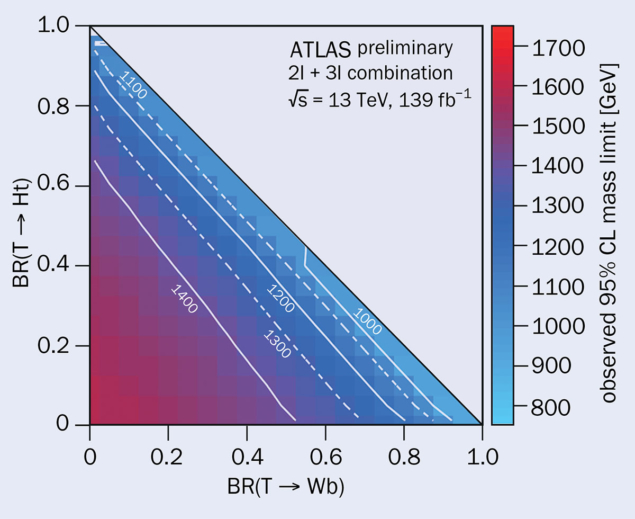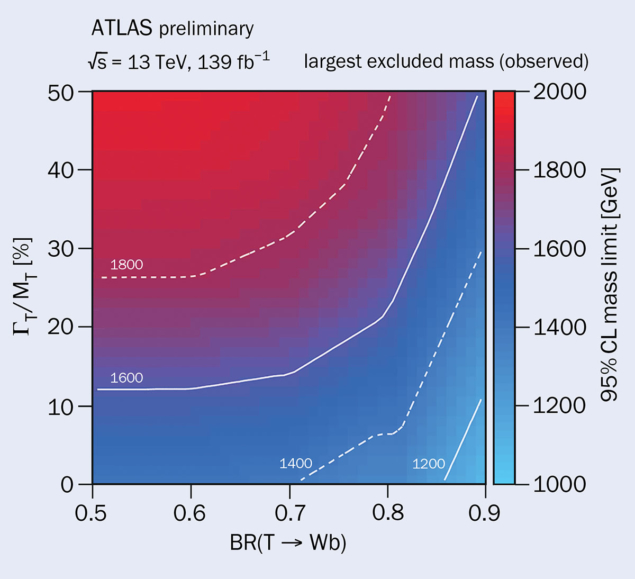A report from the ATLAS experiment

Since the discovery of the Higgs boson at the LHC in 2012, physicists have a more complete understanding of the Standard Model (SM) and the origin of elementary particle mass. However, theoretical questions such as why the Higgs boson is so light remain. An attractive candidate explanation postulates that the Higgs boson is not a fundamental particle, but instead is a composite state of a new, strongly-interacting sector – similar to the pion in ordinary strong interactions. In such composite-Higgs scenarios, new partners of the top and bottom quarks of the SM could be produced and observed at the LHC.
If they exist, VLQs could be very heavy, with masses at the TeV scale, and could be produced either singly or in pairs at the LHC.
Ordinary SM quarks come in left-handed and right-handed varieties, which behave differently in weak interactions. The hypothetical new quark partners, however, behave the same way in weak interactions, whether they are left- or right-handed. Composite-Higgs models, and several other theories beyond the SM, predict the existence of such “vector-like quarks” (VLQs). Searching for them is therefore an exciting opportunity for the LHC experiments.
If they exist, VLQs could be very heavy, with masses at the TeV scale, and could be produced either singly or in pairs at the LHC. Furthermore, VLQs could decay into regular top or bottom quarks in combination with a W, Z or Higgs boson. This rich phenomenology warrants a varied range of complementary searches to provide optimal coverage.
The ATLAS collaboration has recently carried out two VLQ searches based on the full Run–2 dataset (139 fb–1) at 13 TeV. The first analysis targets pair-production of VLQs, focusing on the possibility that most VLQs decay to a Z boson and a top quark. To help identify likely signal events, leptonically decaying Z bosons were tagged in events with pairs of electrons or muons. To maximise the discriminating power between the VLQ signal and the SM background, machine-learning techniques using a deep neural network were employed to identify the hadronic decays of top quarks, Z, W or Higgs bosons, and categorise events into 19 distinct regions.
The second analysis targets the single production of VLQs. While the rate of pair production of VLQs through regular strong interactions only depends on their mass, their single production also depends on their coupling to SM electroweak bosons. As a result, depending on the model under consideration, VLQs heavier than approximately 1 TeV might predominantly be produced singly, and a measurement would therefore uniquely allow insight into this coupling strength.
The analysis was optimised for VLQ decays to top quarks in combination with either a Higgs or a Z boson. Events with a single lepton and multiple jets were selected, and tagging algorithms were used to identify the boosted leptonic and hadronic decays of top quarks, and the hadronic decays of Higgs and Z bosons. The presence of a forward jet, characteristic of the single VLQ production mode, was used (along with the multiplicity of jets, b-jets and reconstructed boosted objects) to categorise the analysed events into 24 regions.

The observations from both analyses are consistent with SM predictions, which allows ATLAS to set the strongest constraints to date on VLQ production. Together, the pair- and single-production analyses exclude VLQs with masses up to 1.6 TeV (see figure 1) and 2.0 TeV (see figure 2), respectively, depending on the assumed model. These two analyses are part of a broader suite of searches for VLQs underway in ATLAS. The combination of these searches will provide the greatest potential for the discovery of VLQs, and ATLAS therefore looks forward to the upcoming Run–3 data.
Further reading
ATLAS Collab. 2021 ATLAS-CONF-2021-024.
ATLAS Collab. 2021 ATLAS-CONF-2021-040.





